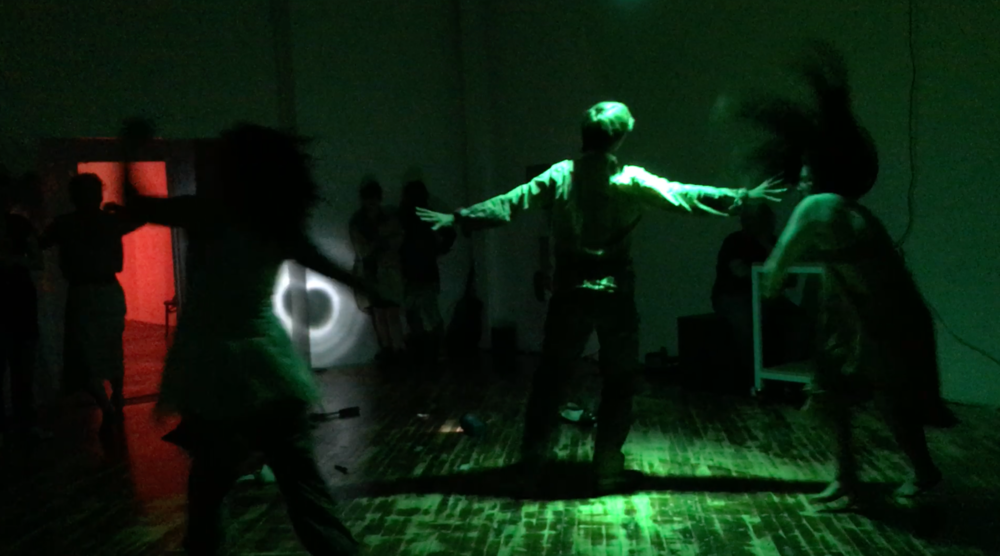
There’s a question that haunts immersive theatre. Okay, there’s a lot of questions that haunt immersive theatre but the one I lose sleep over I call “The Question of Thou.”
What do you do with the audience? How much agency do you endow them with? What is their role — individually and collectively — if any, in the narrative?
These questions came up within the context of Wild Art’s H+G: A Public Outcry, a devised piece that creator Allison M Keating has been working on for a few years in various forms. The latest incarnation took place in three spaces — two rooms and a vestibule — within the Paloma Street Studio at the edge of Downtown LA.
The piece endows the audience with the roles of Hansel and Gretel in a story that folds together the folk tale, drought anxieties and flood narratives. It’s a lot of thematic weight for the four person ensemble to carry, and at times — despite bravely, even maniacally committed performances — the load is more than the company can handle.
Let’s stick with what does work for a moment. I was generously given the ability to see both the first preview of the performance and one very late in the run. While structurally the piece did not evolve drastically the pacing and the comfort of the cast with dealing with the audience did.
Two performances in particular stand out for touching the extremes of the immersive pole.
Lucille Duncan, in the role of the Mother in the story has a monster of a monologue to deliver before the show takes its major peripatetic turn. Calling them in close around her, she addresses the audience as if they were her children. She lays out the hardships the family faces, and the harsh conclusion the parents have come to: that the kids are going to have to fend for themselves in the woods. It’s big, folkloric stuff, and Duncan grounds it — tears running down her face without melodramatic shenanigans — in a way that the intimacy of immersive demands.
Get Noah J Nelson’s stories in your inbox
Join Medium for free to get updates from this writer.
SubscribeSubscribe
On the other end of the spectrum is Craig Gibson’s musically inclined drag queen Suburbanite (aka, the Witch). Like a demonic all-singing, all-dancing Paula Deen, Gibson comes forth when summoned and turns the tone and pacing of the show on its head. Sublimely over the top, there’s a touch of demonic horror in what Gibson provides.
Sometimes the cast errs on the side of confrontation. Murphy Martin’s Father is the first unhinged character that we come across… in the preview he was off kilter from the get go, but his turn into a menacing figure was pulled back by late in the run. Nevertheless, there were sequences in the show where he — and other members of the cast — got downright confrontational with the audience.
Within the world of the story it makes sense, and it’s not like there’s a rule against getting into people’s faces and yelling at them in immersive theatre. The question is how effective is it? This is a question that haunts this show, and it’s one that creator Keating is aware of. It’s a tricky line to ride and one that is very easy to not get right.
The interactive part of immersive theatre — even when the interactivity is just direct address — asks a lot more of actors than pretty much any other form. Film acting doesn’t ask actors to bring unwary spectators into the space of a scene, not does traditional theatre. There’s a safety in the forth wall for actor and audience alike. It was apparent to me on the first preview that the company, which was facing it’s first audience, wasn’t quite sure how to approach this. There were ideas, but reading an audience and following through on how you think an interaction is supposed to go are two different things.
They’re also deceptively similar to the basic acting social contract: your scene partner is generally up for anything short of actual physical violence. This is because once the masks and makeup are off you can call each other on going too far. Worst case: the director can intervene.
That same social contract doesn’t exist between actor and audience in immersive theatre. In fact we often — smartly — find audiences’ roles explicitly spelled out before a show. This is baldly obvious in extreme haunt experiences where the audience has to sign a waiver. Those who self select for that kind of ride are often looking for some rough handling. But that’s the point of something like Blackout. There are horror elements in H+G but the thrust of the piece is more of a lyrical exploration of the folk tale.
That lyricism takes the form of singing, and my God this company can sing. Whether we’re talking three-part harmonies or the haunting voice of Lisa McNeely’s flood victim Guide there’s a power in the unamplified human voice filling a room full of people. There’s something just straight up joyous about listening to performers sing and knowing that nothing is coming between their voice and your ears.
Storytelling wise the piece could continue to evolve. There’s a core here — in the songs, the intimate acting, and the inventive use of simple projections — which is worth developing. Lulls in the action linger a little too long, letting thematic alienation become a drifting inertia. The layering of themes — drought, flood, famine — aren’t always clear. McNeely’s physicality, for instance, clearly illustrates a woman swept away by flood waters. While that’s an interesting contrast to the drought narrative being put forth by Mother and Father, the dissonance doesn’t quite land the way you’d want it to when they are sharing the same physical space. The ideas are there, and become clearer with repeat viewings, but the gut-punch of thematic presence remains just out of reach.
The show could benefit from a multi-room venue: a taller order to be sure, but one that would be hewing closer to Keating’s original vision. (At least, as she expressed it to me.) The other thing the show could use is a tightening of pace. From preview to final weekend the first half of the show picked up considerably, but as currently staged it would have benefited from hurtling along even faster.
These two changes could actually be mutually exclusive. It is entirely possible to imagine a processional version of this piece that would take longer to navigate, but in that process be more satisfying thanks to tonal shifts in physical space. An arrangement that could allow for a more visceral illustration of the ideas haunting this piece.
We will be watching for what form H+G: A Public Outcry takes next.















Discussion